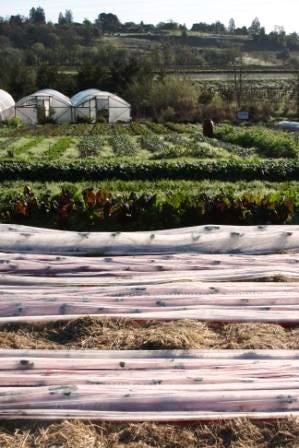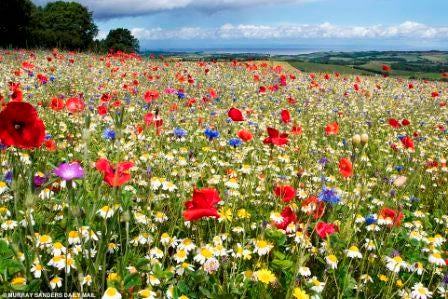#11 What's In A Name?
Why 'Regeneration' Is Best
Welcome to Terra Firma by Courtney White. I’ve spent my life prospecting for innovative, practical, and collaborative answers to pressing problems involving land and people, sharing them with others. I’d like to share them with you!
Don’t miss the next issue, sign up here:
News Item: Here is an article about the shift from the term “sustainable” to “regenerative” and why it’s important for businesses. A quote: “A transition toward regenerative practices could bring a huge win-win for farmers, food companies and the environment.” Although it is sometimes difficult to distinguish between actual practices and marketing pr, this article shows how the times are changing (see).
In the previous issues of Terra Firma, I introduced the principles of the regeneration movement, its potential positive impact on climate change (TF#2), its ability to bring us together (TF#4), the essential role of carbon (TF#5), and examples of on-the-ground success. A recurring theme is a simple one: nature still has the best ideas.
In this issue, I want to look briefly at language, offering some thoughts from my experience. The labels we attach to movements are incredibly important and often define how we react to an idea. This is especially true for work that confronts entrenched and powerful interests, as the food and climate movements do, which always generates public-relations push-back. Words have power!

For years, I didn’t know what to call the burgeoning healthy food and land movement taking place in the early 2000s. It wasn’t simply an extension of the local or organic food movement because it was so much bigger, involving as it did everything from ecosystem restoration to carbon sequestration in soils. Besides, ‘organic’ largely meant ‘stopping harm’ – ie prohibiting the use of industrial chemicals and genetically modified organisms. I was looking for something more proactive and healing.
‘Sustainability’ didn’t cut it – not even close – despite its popularity. It was never clear to me what the word meant. What did we intended to ‘sustain’ as a society? Our over-consumptive lifestyle? Our addiction to growth? Business-as-Usual fueled by solar power instead of oil? Also, despite the honorable intentions of activists and legislators, “sustainable” soon became a marketing ploy used by corporations to dodge any real changes in their practices or goals (called ‘greenwashing’).
There were other terms in use at the time: beyond organic, biodynamic, perennial, permacultural, holistic, natural, and agroecological. Then there were the wide variety of practices, many interlinked: no-till, cover cropping, multi-cropping, agroforestry, silviculture, planned grazing, keyline, grassfed, carbon farming, pollinator-friendly, predator-friendly, to name a few. There were also turf wars - over certification requirements, carbon footprints, and ethical worldviews. If the public felt bewildered, it was little wonder!
This was an important problem to solve for two reasons. First, a fractured movement with too many names was no match for the inevitable push-back attacks by industrial agriculture and their corporate accomplices. A good example was the cynical embrace of the term “climate-smart agriculture” by chemical giant Monsanto, who tried to make a case for their “climate-smart” pesticides, herbicides, and GMOs - an effort that essentially killed the term’s usefulness (see).
Second, the healthy soil and land movement needed unifying a term that reflected its practicality and hopefulness. This wasn’t about coming up with a clever slogan or marketing strategy. It had to be as substantial as the soil below our feet. It also had to umbrella the diverse components of the movement as much as possible while also resonating with the public and not sounding too wonky. A tall order!
For me, an answer arrived suddenly in early 2014 when I visited this place:

This is Singing Frogs Farm, located near Sebastopol, in northern California, owned and operated by Paul and Elizabeth Kaiser. I went there because I was intrigued by the Kaisers’ success at pioneering an innovative practice called year-round farming. Typically, farmers harvest one or two crops each year and then let the land idle until the following spring. That’s what the Kaisers did when they purchased the land in 2007. Neither one had a farming background, though Paul Kaiser had a degree in agroforestry.
As it turns out, their inexperience worked in their favor. After a frustrating first winter dealing with broken machinery, a drop in income, and the necessity of letting their employees go, the Kaisers decided there had to be a better way. Not bound by tradition, they invented a year-round model of farming utilizing a greenhouse to grow seedlings, lots of organic compost spread on the fields (which suppresses weeds), and year-round employees. Their novel idea: when a plant is harvested (by hand) it is immediately replaced by a seedling. It worked and the Kaisers never looked back.
I knew Singing Frogs Farm was organic, no-till, and pollinator-friendly (they planted lots of hedgerows). I also knew they sold their crops through a Community-Supported Agriculture model, which meant they were local. I knew the farm was very profitable too. Paul was on record saying they grossed over $100,000 per crop acre per year. In comparison, a typical organic farm in California grosses between $12,000 and $20,000 per crop acre. That meant Singing Frogs was doing really well!
I knew that the Kaisers considered themselves to carbon farmers having successfully elevated the carbon content of their soil from two to six percent (which is a lot) through their composting and no-till practices. During my visit, I learned that the key was growing the microbial population in the soil, which tripled under the Kaisers’ stewardship. Everything flowed from this vibrant underground world they had fostered – crops, profits, and a high quality-of-life for themselves and their children.
The word they used to describe what was happening on the farm was regeneration. That’s when the light bulb went off for me! Life, biology, carbon, round-and-round. Of course! Here’s a photo of Kaisers:

Words matter. Here’s what various dictionaries say about the word regenerate: to be formed or created again; to be renewed to a better, higher, or more worthy state; to be spiritually reborn; to generate or produce anew, especially after an injury; to restore to original strength or properties; to revive, reform, rekindle, rejuvenate, reconstruct, redeem, reawaken, or reanimate.
Its roots trace back to the Latin word regeneratus which means ‘created again.’ It first appears in English in 1550s and was used in a religious context. Shakespeare uses the word in a secular capacity in Richard II when Bolingbroke (the future King Henry IV) says to his father John of Gaunt “O thou, the earthly author of my blood / Whose youthful spirit in me regenerate.”
This was the word I was looking for – I mean, why try to ‘sustain’ yourself when you can regenerate instead!
That’s what Terra Firma is all about: looking at the world in a positive way, grounded in nature, experience, facts, and hope.
Resources:
Here’s an article about carbon farming and Singing Frogs Farm (2015): https://ediblemarinandwinecountry.ediblecommunities.com/food-thought/hope-under-our-feet-marin-carbon-project
Here’s an article about defining what is meant by ‘regenerative agriculture’: https://www.greenbiz.com/article/fight-define-regenerative-agriculture
Here’s an article making a branding case for regenerative businesses and leadership in all aspects of life (it includes an awesome graphic on global risks): https://sustainablebrands.com/read/defining-the-next-economy/dispelling-5-common-myths-about-regeneration-and-regenerative-business
Here’s a short Washington Post story about a direct-to-consumer food company that is partnering regenerative principles with the new economy: https://www.washingtonpost.com/business/2019/04/24/co-founder-blue-apron-has-his-next-big-idea-it-involves-heirloom-chicken/
The Organic No-Till Farming Revolution by Andrew Mefferd, New Society Publishing, 2019, https://www.newsociety.com/Books/O/The-Organic-No-Till-Farming-Revolution
Video:
Here is a presentation by Paul Kaiser titled ‘Soil is Life, Tillage is Death: a Future with No-till Vegetable Agriculture’ from the 2014 Quivira Coalition conference (see).
Web sites:
Singing Frogs Farm: http://www.singingfrogsfarm.com/
Regeneration organizations:
Australia: https://regenfarmers.com.au/
Vermont: https://regenerationvermont.org/

COURTNEY’S CORNER
~ To the (many) new subscribers of Terra Firma: on my web site you’ll find tons of information about ranching, farming, conservation, and other hopeful work involving land and people over the span of nearly thirty years of writing and activism. See: http://jcourtneywhite.com/
~ Latest book: Fibershed: Growing a Movement of Farmers, Fashion Activists, and Makers for a New Textile Economy by Rebecca Burgess and yours truly, 2019, https://www.chelseagreen.com/product/fibershed/
~ Here’s my pick for the Terra Firma photo of the week - an English meadow to warm your heart in the middle of winter:

Thank you for reading this issue of my newsletter. It is published every Thursday morning – for free! Please consider sharing it with a friend or two or three:
About me: For twenty years I worked to create a radical center among ranchers, conservationists, agencies and others focused on western working landscapes. Today, I am a full-time writer. My nonfiction books include Forewords by Wendell Berry and Michael Pollan. For more information or to contact me visit: www.jcourtneywhite.com
I am also the author of a MYSTERY novel called The Sun. It is a modern-day story set on a working cattle ranch in northern New Mexico (see). To purchase a copy go here.
Here’s an endorsement from Anne Hillerman, New York Times best-selling author of the Leaphorn/Chee/Manuelito mysteries: “In this far-ranging debut novel, Courtney White creates a story worthy of his deep and detailed knowledge of the American West today. Nicely done!”
Terra Firma means ‘solid earth’ or ‘firm ground’ in contrast to air or water. Historically, it was first used by the Republic of Venice to describe its holdings on the Italian mainland.
